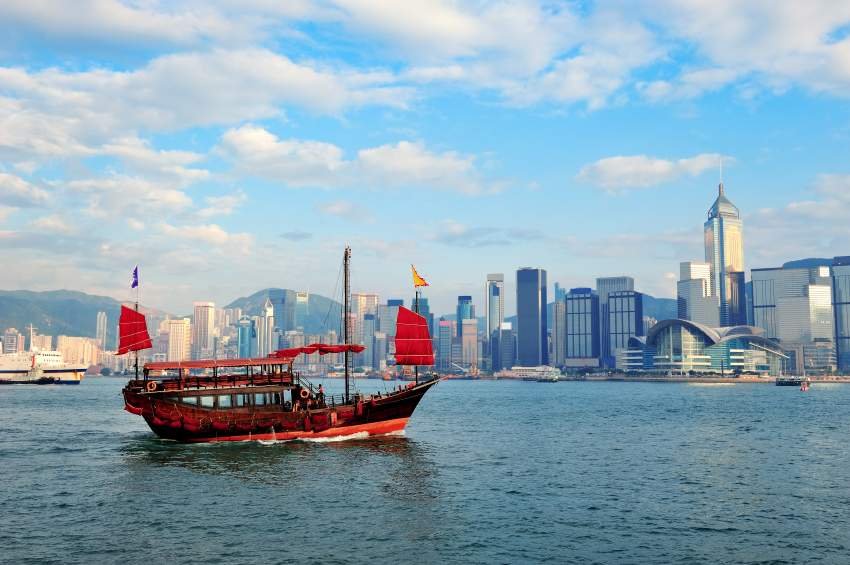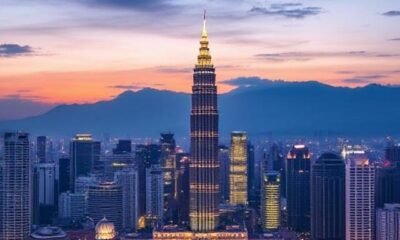Asia Travel Pulse
Hong Kong Celebrates Regional Unity and Tourism Growth with Macau and Guangdong with Hundred Day Countdown to National Games

Saturday, August 2, 2025
Hong Kong is getting ready for the 100-day countdown to the National Games. This event will showcase the city’s commitment to sports and tourism. It will also strengthen connections with its neighboring co-hosts, Macau and Guangdong. The countdown ceremony will take place on Saturday, marking an important step in the city’s preparations for this exciting sporting event. Chief Executive John Lee Ka-chiu, along with important government officials, will lead the event. This shows Hong Kong’s eagerness to host the National Games in a spirit of cooperation.
Countdown Ceremony and Symbolic Events
The celebration will take place at the Velodrome, where Chief Executive John Lee Ka-chiu will be joined by sports and tourism minister Rosanna Law Shuk-pui and Yeung Tak-keung, the head of the National Games Coordination Office in Hong Kong. The event is seen as part of a coordinated effort between Hong Kong, Macau, and Guangdong to not only mark the upcoming Games but also to celebrate the spirit of unity and collaboration across the Greater Bay Area.
In addition to the countdown ceremony, the government will highlight its collective achievements during the “Million Kilometre Challenge.” This initiative has seen Hongkongers participating in various sports activities like biking, running, and walking. Already, the community has collectively accumulated 999,900 kilometers, with Law and Yeung expected to complete the final 100 kilometers during the ceremony. This challenge is symbolic of the dedication and community spirit that the National Games aim to foster among local residents.
Expanding the National Games’ Impact Across the Region
Following the countdown event, Lee will head to Shenzhen to participate in an evening celebration, which will be one of several events across the mainland to mark the milestone. The Greater Bay Area, which includes Hong Kong, Macau, and Guangdong, is a major focus for these celebrations, as the region strives to deepen its coordination and enhance mutual development through sport.
On Sunday, Law and Yeung will continue their participation in the countdown by attending a fitness day at Go Park Sai Sha, where a carnival will be hosted by the Hong Kong Guangdong Youth Federation. The event is designed to serve as a bridge between Hong Kong, Guangdong, and Macau, with sports and tourism professionals working to strengthen the region’s collaborative efforts. This celebration not only promotes physical activity but also strengthens ties between the youth of the three regions.
Macau and Guangdong Join the Celebration
The momentum of the countdown has also been felt across Hong Kong’s neighboring regions, with Macau and Guangdong hosting their own events. In Macau, a symbolic event was held at the famous Ruins of St. Paul’s, where participants formed a giant “100” symbol. This visual representation of unity underlines the spirit of cooperation and mutual support that has defined the preparations for the National Games. Similarly, in Guangzhou, the city took part in several days of drone demonstrations to mark the occasion and further build excitement for the upcoming Games.
These coordinated celebrations are more than just symbolic; they represent a unified effort to present the Greater Bay Area as a hub for sports, tourism, and cultural exchanges. The region’s collective engagement not only enhances the National Games’ significance but also showcases the growing influence of sports in fostering cross-border collaboration.
Hong Kong’s Preparation for Major Sporting Events
The countdown event also provided a platform for Hong Kong’s organizers to highlight the city’s progress in hosting the National Games. A week earlier, at a separate event in Beijing, Chan Kwok-ki, the vice-president of the organizing committee and Hong Kong’s chief secretary for administration, discussed the government’s efforts to ensure that the Games are a success. Chan described the National Games as a “major priority” for the Hong Kong government, with various departments working together to finalize the preparations.
These efforts, according to Chan, will serve as a foundation for Hong Kong to host more mega sports events in the future. By learning from the experience of hosting such a large-scale event, Hong Kong aims to strengthen its position as a global sports hub, with plans to further boost the tourism sector and improve infrastructure for future sporting competitions.
The National Games and Tourism
The National Games represent a major opportunity for Hong Kong to boost its tourism sector, particularly by attracting international visitors who are drawn to the region’s exciting sports offerings. The Games will not only celebrate local sports culture but will also bring significant international attention to the city. With tourism being a key economic driver for Hong Kong, the National Games are expected to create a ripple effect that will benefit the city’s hospitality industry, transportation services, and retail sectors.
Increased tourism flows will also benefit neighboring regions like Macau and Guangdong, as visitors to Hong Kong often explore the wider Greater Bay Area. This interconnectedness enhances the region’s appeal as a tourist destination, where visitors can experience a combination of modern sporting events, rich cultural heritage, and exceptional landscapes.
A Future of Sporting Collaboration
As the countdown to the National Games continues, Hong Kong, along with its co-hosts Macau and Guangdong, is ready to show the benefits of working together through sports. The celebrations will include community participation and large events, emphasizing the region’s focus on unity and the development of sports culture.
The National Games will play an important part in Hong Kong’s future as a global sports destination. With careful planning and teamwork across the Greater Bay Area, Hong Kong will be firmly established as a sports hub, helping the city grow as a top travel and tourism spot.
Asia Travel Pulse
Azerbaijan Unlocks Central Asia Tourism Potential, Attracting Record Numbers from Kazakhstan and Uzbekistan with Strategic Initiatives and Seamless Connectivity : New Update You Need to Know

Sunday, August 3, 2025
Azerbaijan is successfully unlocking the tourism potential of Central Asia, particularly attracting record numbers of visitors from Kazakhstan and Uzbekistan. This surge in tourism can be attributed to a series of strategic initiatives, including visa-free travel for citizens of both countries and the expansion of direct flight routes to Baku. These efforts have made Azerbaijan more accessible and appealing to Central Asian travelers. Additionally, Azerbaijan’s rich cultural heritage, stunning landscapes, and vibrant cities, combined with targeted promotional campaigns and events like Dream Fest, are drawing increasing attention from the region, solidifying its position as a top travel destination.
Azerbaijan is making significant efforts to boost its tourism sector by targeting visitors from Central Asia, with a particular emphasis on attracting travelers from Kazakhstan and Uzbekistan. With growing interest in Azerbaijan’s rich cultural heritage, beautiful landscapes, and vibrant cities, the country is making efforts to tap into the potential of these neighboring regions.
To promote these efforts, the Azerbaijan Tourism Board recently organized a familiarization trip for tourism representatives from Kazakhstan and Uzbekistan. The objective was to showcase the wide array of tourism experiences available throughout Azerbaijan.The tour included visits to Baku, the nation’s lively capital, as well as scenic spots such as Shamakhi and Basqal, known for their picturesque landscapes and historic significance. The participants also explored the Caspian Sea coastline, visiting popular beach resorts and hotels that offer a relaxing getaway.
A standout event during the trip was the Dream Fest, a renowned annual music festival hosted at the Sea Breeze Resort. This event has become a favorite among regional travelers, offering a blend of entertainment, cultural performances, and an idyllic beachside setting. Dream Fest has grown in popularity, attracting a large crowd and contributing to the country’s status as a key cultural destination for tourists seeking both relaxation and unique experiences.
The familiarization tour also included a business-to-business networking session, where nearly 60 Azerbaijani destination management companies and hotels participated. This session was designed to strengthen tourism partnerships between Azerbaijan and Central Asia, laying the foundation for long-term collaboration and tourism development. These meetings provided a valuable opportunity for stakeholders to discuss future projects and initiatives aimed at expanding tourism between the regions.
Azerbaijan has begun to witness encouraging outcomes from its initiatives aimed at drawing more tourists from Central Asia. According to the Azerbaijan Tourism Board, over 68,000 visitors from Kazakhstan and Uzbekistan traveled to Azerbaijan during the first half of this year, reflecting a 15 percent growth compared to the same period in the previous year. This growth can be attributed to the country’s visa-free travel policy for citizens of both Kazakhstan and Uzbekistan, making it easier for tourists to visit. Additionally, the expansion of direct flights from multiple cities in both countries to Baku has played a significant role in simplifying travel and increasing accessibility.
At present, travelers have the convenience of flying directly to Baku from four cities in Kazakhstan and two cities in Uzbekistan. With airlines like AZAL, FlyArystan, Air Astana, Uzbekistan Airways, and Centrum Air operating regular flights, the journey takes approximately three hours, offering a fast and convenient option for Central Asian visitors. This ease of access has contributed to a surge in both leisure and business tourism, providing a boost to Azerbaijan’s growing tourism sector.
The rise in tourism is also closely tied to the strengthening economic and cultural connections between Azerbaijan and Central Asia. Azerbaijan has focused on strengthening these relationships, seeing tourism as an important avenue for enhancing diplomatic and economic collaboration. In addition to improved air connectivity, there are also plans to introduce a high-speed passenger ferry service between Aktau (Kazakhstan) and Baku, further enhancing tourism connectivity across the Caspian Sea. This proposal reflects Azerbaijan’s commitment to fostering seamless travel options and improving regional tourism integration.
Azerbaijan’s commitment to developing its tourism sector is evident in the country’s long-term strategic planning. In 2018, the nation launched the “Take Another Look!” campaign, accompanied by a new tourism logo aimed at rebranding Azerbaijan as a premier global destination. In that same year, the State Tourism Agency established six international offices in strategically important markets, such as Russia, the UAE, Saudi Arabia, India, China, and Germany. These efforts were designed to raise global awareness of Azerbaijan’s unique offerings, ranging from its cultural landmarks to its diverse landscapes.
The success of these initiatives was evident in 2019 when Azerbaijan welcomed a record 3.2 million international visitors, a significant increase from previous years. However, the COVID-19 pandemic severely impacted global tourism, with the number of international visitors dropping to just 795,000 in 2020 due to border closures and travel restrictions. Despite these challenges, Azerbaijan’s tourism sector is on the path to recovery, with a growing number of travelers returning to explore the country’s offerings.
Azerbaijan is unlocking Central Asia’s tourism potential by attracting record numbers of visitors from Kazakhstan and Uzbekistan through strategic initiatives, including visa-free travel and expanded direct flights, alongside its rich cultural offerings and targeted promotional campaigns.
In conclusion, Azerbaijan’s tourism sector is demonstrating resilience as it adapts to a post-pandemic world. Through strategic investments in infrastructure, strengthened relationships with neighboring regions, and the promotion of unique travel experiences, the country is positioning itself as a leading destination in Central Asia. With its rich cultural heritage, natural beauty, and hospitality, Azerbaijan is set to continue attracting increasing numbers of visitors, establishing itself as a key player in the region’s tourism market.
Asia Travel Pulse
Malaysia, Thailand, China and India Shape the New Face of Asian Tourism as Visa-Free Travel and Safety Concerns Shift Traveler Flows Across the Region

Sunday, August 3, 2025
The landscape of Asian tourism is undergoing a dramatic transformation in 2025, with Malaysia, Thailand, China, and India emerging as key players in a shifting regional travel narrative. Malaysia has surged ahead as a top destination by offering visa-free access to millions and investing heavily in airport infrastructure and traveler safety, attracting record numbers of international arrivals. Meanwhile, Thailand—long considered the region’s tourism leader—has seen a dip in confidence due to natural disasters, security incidents, and escalating border tensions that have led to widespread booking cancellations. On the other side of the equation, outbound travelers from China and India are driving this change, with Chinese tourists pivoting toward safer and more accessible destinations like Malaysia, and Indian travelers taking advantage of relaxed visa rules to explore the region more freely. Together, these four countries are reshaping how, where, and why people travel across Asia in 2025.
Visa-Free Travel Opens the Door for Growth
A major catalyst behind Malaysia’s rise is its proactive visa exemption policy, which has eliminated bureaucratic barriers for millions of travelers. Visitors from key tourism markets have benefited from smoother and faster entry procedures, helping drive traffic during peak and off-peak periods alike.
Malaysia recently extended its visa-free access for citizens of China, offering a five-year exemption with a future option to extend it through the next decade. This move has streamlined the travel process and positioned Malaysia as an attractive destination for tour operators, families, and repeat visitors. Likewise, tourists from India can enter Malaysia without a visa through 2026, further widening the country’s appeal across the Asian continent.
These relaxed travel policies have been instrumental in converting interest into bookings, especially from travelers seeking convenient, no-hassle getaways.
Airport Infrastructure Scaled for Surge
To meet the growing influx of visitors, Malaysia has expanded and upgraded key infrastructure—particularly at its primary international gateway. Terminal 1 at Kuala Lumpur International Airport has undergone a major improvement valued at RM30 million (US\$7 million). This renovation focused on optimizing passenger flow, expanding facilities, and accommodating rising international traffic.
With enhanced terminal operations, better baggage handling, and streamlined immigration counters, the airport now serves as a more efficient entry point for the millions of tourists choosing Malaysia this year. The improvements have also improved Malaysia’s image as a modern and capable host for long-haul and regional travelers.
Travel Confidence Boosted Through Security Reinforcement
Beyond accessibility, Malaysia’s strategic focus on border security and travel safety has played a key role in maintaining traveler confidence. The government has tightened screening measures and refused entry to large numbers of passengers from flights identified as high-risk. This preventive approach, coupled with increased airport surveillance and a visible security presence, has reduced risks and reassured international arrivals.
The emphasis on maintaining a safe environment has become particularly significant in 2025, with global travelers paying closer attention to destinations that offer peace of mind alongside memorable experiences. Malaysia’s firm stance on security has helped it stand out among its regional competitors.
Thailand Faces Setbacks in a Difficult Year
In contrast, Thailand’s tourism sector has faced multiple disruptions in the early part of the year, affecting its ability to maintain momentum. Several safety-related incidents and environmental crises have eroded traveler confidence, leading to a drop in forward bookings and arrival numbers.
An international incident involving tourists early in the year drew widespread media attention and created concern over traveler safety. Just weeks later, a powerful earthquake struck in late March, causing travel delays, infrastructure challenges, and cancellations across several provinces. These disruptions were followed by tensions along the eastern border, which escalated into military activity, resulting in widespread cancellations at hotels and resorts near affected regions.
As uncertainty grew, some source markets issued advisories, and travelers began to reroute their trips to alternative destinations across the region.
Regional Tourism Landscape Undergoes Realignment
For years, Thailand enjoyed a dominant position in Southeast Asia’s tourism industry, consistently drawing millions with its beaches, festivals, and culinary offerings. However, the events of 2025 have changed the playing field, allowing Malaysia to rise and take center stage.
Malaysia’s ability to align visa policy, airport upgrades, and public safety under a cohesive tourism strategy has proven highly effective. Destinations such as Langkawi, Sabah, Penang, and Sarawak are also drawing more international attention, offering travelers alternatives beyond traditional urban centers.
This broader promotion of diverse locations has distributed tourist traffic more evenly across the country and contributed to record-high occupancy rates in several secondary regions.
A New Tourism Leader Emerges
With global airlines increasing connectivity to Malaysian cities and digital marketing campaigns drawing attention to lesser-known gems, the country is well-positioned to maintain its momentum through the remainder of 2025.
While Thailand remains a strong competitor, its recovery will hinge on how effectively it restores confidence and stabilizes the domestic situation. For now, Malaysia’s coordinated approach has not only earned it the top spot in regional arrivals—it has also redefined what effective tourism leadership looks like in a changing world.
Asia Travel Pulse
Thailand Tourism Faces Decline Amid New Safety Concerns and Drop in the Foreign Tourists Arrivals

Saturday, August 2, 2025
Thailand–the region’s No.2 economy in Southeast Asia–is seeing tourism confidence index plunge steeply during Q2 of 2025. That decline in arrivals is a reflection of the city’s growing safety concerns and also brings alarm for the country’s tourism industry, which has seen sharply reduced numbers of visitors. That index, a key measure of the health of tourism was down to 70 percent from its pre-pandemic benchmark of 100. The fall is also being added by a number of negative factors which have somewhat dampened attitude among potential international travelers.
Significant Drop in Tourism Confidence
According to the Tourism Council of Thailand (TCT), the tourism confidence index in the second quarter of 2025 was recorded at 70, a significant dip from the 83 registered in the first quarter of the year. Compared to the same period last year, when the index stood at 79, the drop reflects growing unease in the tourism sector. These figures were derived from a nationwide survey conducted between May 25 and June 10, which included responses from 740 tourism operators across the country.
This drop in the index signals a combination of factors contributing to the country’s tourism challenges. In particular, concerns related to safety have deterred tourists from visiting Thailand, a country known for its rich culture, stunning beaches, and vibrant cities. The data suggests that tourism operators are facing more significant challenges in 2025 compared to previous years, especially as the industry continues to recover from the effects of the pandemic.
Forecast for Foreign Visitors in 2025
The downturn in Thailand’s tourism industry is further reflected in the TCT’s revised forecast for foreign arrivals in 2025. The council projects that Thailand will welcome only 33.3 million foreign visitors this year, a notable decline from 37 million international arrivals in 2024. This 10% decrease in tourist numbers is attributed to safety concerns, recent geopolitical tensions, and global events, all of which have strained the tourism industry. The lowered forecast highlights the struggles Thailand’s tourism sector is facing in maintaining its pre-pandemic growth.
While Thailand has long been a popular destination for international tourists, the decline in foreign arrivals—particularly from China—signals a troubling trend that needs to be addressed if the country hopes to recover its status as a leading global tourist destination.
Impact of Safety Concerns and Negative Events
Several high-profile incidents have contributed to the drop in tourism confidence in Thailand. One of the most notable was the kidnapping of Chinese actor Xing Xing in January 2025, which was linked to a scam syndicate operating in Myanmar. This incident had a significant impact on Chinese tourists, resulting in a dramatic drop of over 50% in arrivals from China. The negative publicity surrounding the case and the subsequent concerns about safety have made many Chinese travelers hesitant to visit Thailand.
In addition to the kidnapping incident, a major earthquake that struck Thailand on March 28, 2025, raised further concerns about the country’s safety. While the earthquake was not catastrophic, it still drew attention to Thailand’s vulnerability to natural disasters, contributing to the overall decrease in tourist confidence.
Decline in Chinese Tourists
The decrease in Chinese tourist arrivals has been one of the most significant factors in the decline in Thailand’s tourism figures. According to the Ministry of Tourism, from January 1 to July 27, 2025, Thailand recorded 18.98 million foreign arrivals, a 6.18% decrease compared to the same period in 2024. Despite this overall drop, China remains the largest source of international tourists to Thailand, with 2.64 million Chinese nationals visiting the country during the first seven months of 2025.
The sharp drop in Chinese visitors has raised alarms within Thailand’s tourism sector, as Chinese tourists have traditionally represented a significant portion of the country’s foreign arrivals. This decline, combined with the ongoing safety concerns and the natural disaster, has prompted many Chinese travelers to reconsider their plans to visit Thailand.
Economic Impact on Thailand’s Tourism Industry
Thailand’s tourism sector plays a vital role in the country’s economy, contributing significantly to its GDP and providing millions of jobs in hospitality, transport, and retail. The reduction in foreign arrivals is already beginning to have noticeable economic consequences, particularly in regions that heavily depend on tourism. The drop in Chinese tourist numbers is especially concerning, as Chinese visitors typically spend more during their stay than other international tourists, helping to drive the local economy.
Moreover, Thailand faces rising competition from other Southeast Asian destinations, which are increasingly attracting tourists who are seeking similar cultural experiences with fewer safety concerns. Countries like Vietnam, Malaysia, and Indonesia are capitalizing on shifting travel preferences, offering tourists alternative options that may seem more secure or less affected by geopolitical tensions.
Can Thailand Rebound from the Current Decline in Tourism ?
These are new challenges and the fall off in Thailand’s tourism confidence index for 2Q2025 also offers a sign of additional difficulties that national travel businesses face at this time, amidst safety concerns and global events. The fall in foreign arrivals, especially from China, highlights the fallout of recent negative events such as the kidnapping of a Chinese actor and March’s earthquake. Against a newly projected 33.3 million foreign tourists by the year 2025, Thailand’s tourist industry is going to have to face these issues and come up with initiatives that will rejuvenate trust in its international guests from everywhere around the world.
While Thailand rebuilds its tourism industry, the government and key stakeholders need to prioritize enhancing safety procedures as well as counteracting global negative events in order to maintain international travelers’ confidence that this country will remain a wonderful place for visitors over the long-run.
-

 Brand Stories2 weeks ago
Brand Stories2 weeks agoBloom Hotels: A Modern Vision of Hospitality Redefining Travel
-

 Brand Stories1 week ago
Brand Stories1 week agoCheQin.ai sets a new standard for hotel booking with its AI capabilities: empowering travellers to bargain, choose the best, and book with clarity.
-

 Destinations & Things To Do2 weeks ago
Destinations & Things To Do2 weeks agoUntouched Destinations: Stunning Hidden Gems You Must Visit
-

 Destinations & Things To Do1 week ago
Destinations & Things To Do1 week agoThis Hidden Beach in India Glows at Night-But Only in One Secret Season
-

 AI in Travel2 weeks ago
AI in Travel2 weeks agoAI Travel Revolution: Must-Have Guide to the Best Experience
-

 Brand Stories4 weeks ago
Brand Stories4 weeks agoVoice AI Startup ElevenLabs Plans to Add Hubs Around the World
-

 Brand Stories3 weeks ago
Brand Stories3 weeks agoHow Elon Musk’s rogue Grok chatbot became a cautionary AI tale
-

 Asia Travel Pulse4 weeks ago
Asia Travel Pulse4 weeks agoLooking For Adventure In Asia? Here Are 7 Epic Destinations You Need To Experience At Least Once – Zee News
-

 AI in Travel4 weeks ago
AI in Travel4 weeks ago‘Will AI take my job?’ A trip to a Beijing fortune-telling bar to see what lies ahead | China
-

 Brand Stories4 weeks ago
Brand Stories4 weeks agoChatGPT — the last of the great romantics













You must be logged in to post a comment Login